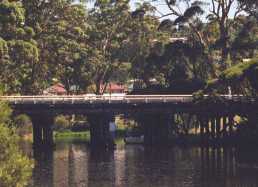
 |
Denmark River |
| Denmark River at a glance | |||
| Catchment area: | 800 square kilometres |
||
| Average annual rainfall over catchment: | 800 millimetres | ||
| River length: | 60 kilometres | ||
| Annual discharge volume into inlet: | 30,548 Megalitres | ||
| Percentage cleared: | 28% | ||
| Extent of tidal influence: | 2.5 kilometers | ||
| River health: | marginally saline | ||

The fringing vegetation of the river valleys represents a significant ecological corridor connecting patches of remnant bush along the banks of the river. In 1995 only 49% of the Denmark foreshore that bordered agricultural land was fenced off, while 49 hectares of the Denmark foreshore area was identified as in need of revegetation. In total, 80 kilometres of the Denmark River were surveyed. Of this length, about 62% of the riparian zone was pristine, 25% degraded and 13% erosion prone. Overall about 49 hectares of river valley embankment and foreshore requires revegetation to stabilise the banks, maintain ecological corridors and protect river pools. In areas where farmland adjoined the Denmark River approximately 49% of the foreshore was already fenced. A further 38.2 kilometres of fencing was required at that time. The middle and lower sections of the river are very scenic and contain foreshore generally of a high quality. Even so, points of erosion and subsidence and sections of extensive degradation do occur. The increasingly saline upper half of the river is degraded, exhibiting erosion along fire breaks located within the floodplain of the river valley, siltation and some vegetation die-off, as a result of salinisation.
The river water quality is marginal, with an elevated salinity caused by clearing in the upper catchment. Although only a small proportion of the upper catchment has been cleared, it has been sufficient to affect the quality of water collected in dam built to supply the township of Denmark.
The river water salinity has increased from about 40 mg/litre in 1940 to about 500 mg/litre in the early 1990s. For this reason catchment clearing control has been imposed and tree planting carried out in the upper catchment to prevent further deterioration and hopefully to improve water quality.
The water flows all year.
In 2005 a project (Our Living Rivers) was set up to collect and analyse data, enabling the Department of Water to monitor the health of the river over time and help determine what systems need better protection. In spring 2006 and 2007 samples were taken from the river system to assess the quality of the water and habitat as well as the presence of fish and macroinvertebrates. Two sites were sampled on the Denmark River system and two on the Quickup River tributary.
Further Information:
South Coast Regional Land and Water Care Strategy: The Albany Hinterland Sub-region Prepared by: the South Coast Regional Assessment Panel and the South Coast Regional Initiative Planning Team: December 1996.